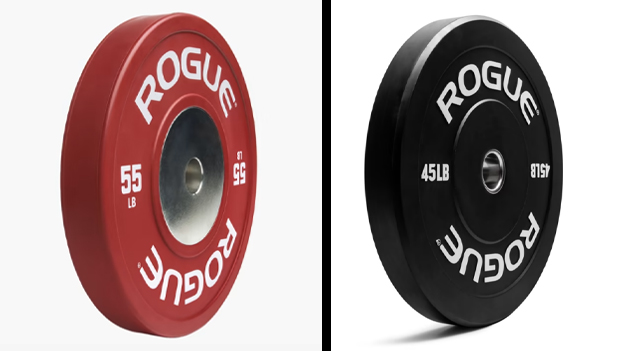
Have you ever been asked, "Do you even lift?"
If your answer was something like, "Well, I would, as I too want to look like The Rock, but, jeez, it seems complicated and a little scary," fear not. Weightlifting is one of my favorite activities, but when I started CrossFit, and in turn lifting, I had no idea that there were different kinds of barbells and weight plates. I quickly learned that not only were there Olympic weights and standard weights, but that knowing the differences between them would help me reach specific goals and also help keep my lifting buddies and me safe and sound as we strive for each new PR.
Although on a basic level, weight plates are heavy round objects with a hole in the middle, there are some major differences when it comes to Olympic weights vs. standard plates. In this guide, we will break down the differences between the two types and let you know if one is better than the other for the type of lifting you’re doing.
Why Trust Us?
ACTIVE.com's editorial team relies on the knowledge and experience of fitness and wellness experts including competitive athletes, coaches, physical therapists, nutritionists, and certified trainers. This helps us ensure the products we feature are of the highest standard. Collectively, the team has spent countless hours researching equipment, gear, and recovery tools in order to create the most accurate, authentic content for our readers. Customer satisfaction is also a key part of our review process, which is why we only feature products that are highly rated.
Olympic Weights vs. Standard Weights Overview
By clicking on the product links in this article, we may receive a commission fee at no cost to you, the reader. Sponsorships and affiliate commissions help support our research so we can help you find the best products. Read the full affiliate disclosure here.
At first glance, weight plates look fairly similar. Therefore, it may come as a surprise to learn that there are many nuances to these straightforward pieces of workout equipment. Standard weight plates are an excellent option for those who are only just beginning their love affair with weightlifting or love the high-rep workouts associated with CrossFit, HIIT, or many of the increasingly popular weightlifting apps. These kinds of bumper plates will also help protect your floor.
If you are interested in honing in on the intricacies of Olympic lifts or want to start entering weightlifting competitions, you will definitely want to get familiar with Olympic plates. Although you can perform Olympic lifts—cleans, jerks, and snatches—with standard plates, you will not be able to use them in competition because they won't meet International Weightlifting Federation (IWF) standards.
Our Top Picks
- REP Fitness Competition Bumper Plate Sets
- REP Fitness Pinnacle Plate Sets
- Titan Fitness Cast Iron Olympic Plates
- Titan Fitness Economy Classic Black Bumper Plates
- Rogue Color Training 2.0 Plates
- Rogue Echo Bumper Plates V2
Olympic Weights vs. Standard Weights: What's the Difference?
One of the most important differences is the diameter of the hole in the middle of the plate. Standard weight plates come with a hole that is 1 inch in diameter, while the openings on Olympic weights are almost double that with a diameter that is just under 2 inches. The size difference of the hole means that Olympic plates are slightly larger overall. It also means that standard plates will not fit on an Olympic barbell because the shaft of that type of bar is too large, but Olympic plates will slide onto a standard bar.
Olympic plates come equipped with a steel ring that allows them to slide on and off the bar easily. If you are using competition plates, these steel rings will be encased in rubber, which helps protect the weight and the floor. Additionally, these weights will often be coated in polyurethane, which helps reduce bouncing after a weight has been dropped.
Standard plates are a cost-effective alternative to their more expensive Olympic cousins. Therefore, for those new to weightlifting, they are an excellent way to get started. You can buy more weights for the money, or if you plan to move only light-to-moderate loads, these will be excellent additions to your home gym.
Additionally, Olympic plates are generally offered in higher-weight increments. This allows you to load more weight on the barbell because you don't have to use several plates to achieve a particular weight, thus leaving more room on the bar for additional plates.
Olympic Weights vs. Standard Weights: Which Is Better?
Olympic weights are usually made with higher-quality materials that allow them to take a beating and come back for more. Additionally, they come in heavier weight increments and slide on and off the bar smoothly. That said, they are also considerably more expensive. So, if weightlifting is simply something that you do as part of your overall health and wellness journey and not necessarily a lifestyle, standard plates may be more than sufficient for you.
Standard plates are ideal for people who don't plan on lifting strongman-type loads and those who don't plan on entering weightlifting competitions. They are excellent for those wanting to practice their lifts or participate in workouts that call for high reps and light-to-moderate weights.
When it comes down to it, it is more about what type of weights are better for your purpose.
FAQs About Olympic vs. Standard Weights
Can I use Olympic weights on a standard bar?
You can use Olympic weights on a standard bar, but you can't use standard weights on an Olympic bar. This is because of the difference in the sizes of the plates’ holes and the size of the shafts of the bars.
Are Olympic weights easier?
Olympic weights tend to slide on and off of the bars easily due to the smooth steel rings that make up the hole where the shaft is inserted.
Why do Olympic weights feel heavier than standard weights?
Olympic weight plates are available in heavier increments and often take up less space due to the materials.


